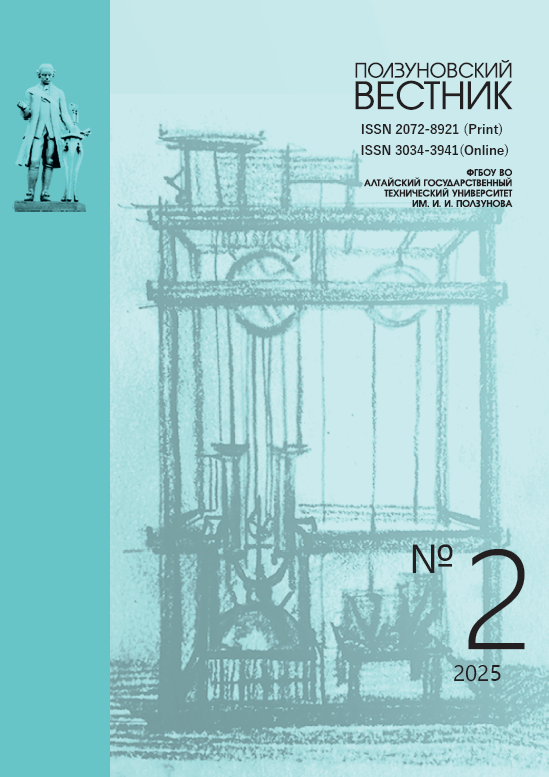PECULIARITIES OF MICROSTRUCTURE AND COMPOSITION FAT PHASE OF BUTTER FROM DAIRY AND WHEY CREAM
YNQHEB
DOI:
https://doi.org/10.25712/ASTU.2072-8921.2025.02.013Keywords:
dairy products, whey cream, whey butter, microscopy, structure, fatty acid composition of the fat phase.Abstract
The article presents the results of research on cheese and milk cream, as well as the oil produced from them. The purpose of this work was: to study the microstructure of whey cream and milk cream-raw materials, as well as butter extracted from them; to study the fatty acid composition of the fatty phase of butter from whey cream and milk cream. Microstructure studies were carried out using an MBI-6 microscope at an increase of x280 times. It was found that the average diameter of the fat ball in whey cream was 9.6 microns, in dairy - 11.0 microns. It was found by calculation that in ripe both dairy and subcutaneous cream, the main share (more than 50.0 %) is made up of fat balls with a diameter from 4.0 to 10.0 microns. The degree of dispersion of fat particles in whey cream is slightly higher than in dairy, which is explained by the smaller number of large fat balls in them, most of which turn into cheese. It was revealed that the microstructure of the podsyrny oil, in comparison with sweet-cream oil, has distinctive features consisting in a reduced degree of plasma dispersion. This is due to the peculiarities of the composition of whey cream and the technology of their production. The analysis of the fatty acid composition of the fatty phase of the subsurface oil in comparison with sweet-cream oil was carried out by gas chromatography. It has been revealed that the fat phase of butter contains less saturated fatty acids, including low molecular weight volatile ones, as well as slightly more unsaturated fatty acids than in sweet butter of a similar composition. This is also explained by the raw materials and technological features of the cycle of obtaining butter from whey cream.
References
Храмцов А.Г., Борисенко А.А., Евдокимов И.А., Борисенко А.А., Брацихин А.А., Борисенко Л.А. Эволюция переработки молочной сыворотки: про-шлое, настоящее, будущее (часть 2). Современная наука и инновации. 2021; (3): 126–139. https://doi.org/10.37493/2307-910X.2021.3.12.
Климова М.Л. Инновационные технологии повышения рентабельности молокоперерабатывающих предприятий: переработка молочной сыворотки. Актуальные вопросы переработки мясного и молочного сырья. 2011; (6): 104–121.
Кручинин А.Г. Современное состояние рынка вторичных сырьевых ресурсов молочной промышленности / А.Г. Кручинин, А.В. Бигаева, С.Н. Туровская, Е.Е. Илларионова // Ползуновский вестник. 2022. № 4. т. 1. С. 140–149. doi: 10.25712/ASTU.2072-8921.2022.04.018.
Топникова Е.В., Волкова Т.А. (2023). Вопросы переработки молочной сыворотки. Сыроделие и маслоделие. 2023. № 4. С. 76–80.
Мельникова Е.И., Станиславская Е.Б. Получение и применение микропартикулята сывороточных белков в технологии производства сметаны. Пищевые системы. 2021; 4(2):117–125. https://doi.org/10.21323/2618-9771-2020-4-2-117-125.
Rama G.R., Kuhn D., Beux S., Maciel M.J. & de Souza C.F.V. (2019). Potential applications of dairy whey for the production of lactic acid bacteria cultures. International Dairy Journal, 98, 25–37. (In Russ.) doi. 10.1016/j.idairyj. 2019.06.012.
Kilara A. (2015). Whey and whey products. Dairy processing and quality assurance, 349−366. https://doi.org/ 10.1002/9781118810279.ch15.
Lappa I.K., Papadaki A., Kachrimanidou V., Ter-pou A., Koulougliotis D., Eriotou E. & Kopsahelis N. (2019). Cheese whey processing: integrated biorefinery concepts and emerging food applications. Foods, 8(8), 347. (In Russ.). doi.org/10.3390/foods8080347.
Panghal A., Patidar R., Jaglan S., Chhikara N., Khatkar S.K., Gat Y. & Sindhu N. (2018). Whey valorization: current options and future scenario - a critical review. Nutrition & Food Science, 48(3), 520-535. (In Russ.) doi.org/10.1108/NFS-01-2018-0017.
Храмцов А. Г. Переработка вторсырья. 2003.
Вышемирский Ф.А., Красуля Н.Г. & Иванова Н.В. (2003). Новая технология сливочного подсырного масла. Сыроделие и маслоделие, 4, 3–5.
Грищенко А.Д. (1983). Сливочное масло. Москва : Легкая и пищевая промышленность. 20‒21.
Rønholt S., Mortensen K. & Knudsen J.C. (2013). The effective factors on the structure of butter and other milk fatbased products. Comprehensive Re-views in Food Science and Food Safety, 12(5), 468−482. https://doi.org/10.1111/1541-4337.12022.
Rønholt S., Kirkensgaard J.J.K., Mortensen K., Knudsen J.C. (2014). Effect of cream cooling rate and water content on butter microstructure during four weeks of storage. Food Hydrocolloids, 34, 169–176. https://doi.org/10.1016/ j.foodhyd.2012.10.
Rønholt S., Kirkensgaard J.J.K., Pedersen T.B., Mortensen K. & Knudsen J.C. (2012). Polymor-phism, microstructure and rheology of butter. Effects of cream heat treatment. Food chemistry, 135(3), 1730–1739. https://doi.org/ 10.1016/j.foodchem.2012.05.087.
El-Bakry M., Sanchez A. & Mehta B.M. (Eds.). (2018). Microstructure of Dairy Products. Chichester (UK): John Wiley & Sons Ltd. 145–171.
Aly A.H. (2009). Fatty acid composition, textur-al and organoleptic properties of whey butter. Journal of Food and Dairy Sciences, 34(4), 3081–3094.
Jinjarak S., Olabi A., Jiménez-Flores R. & Walker J.H. (2006). Sensory, functional, and analytical comparisons of whey butter with other butters. Journal of Dairy Science, 89(7), 2428–2440. http://dx.doi.org/10.3168/jds.S0022-0302(06)72316-5.
Мордвинова В.А., Топникова Е.В., Данилова Е.С., Остроухова И.Л. (2022). Влияние изменений в жировой фазе на особенности формирования показателей качества полутвердых и твердых сыров. Пищевые системы, 5(4), 361–368. https://doi.org/10.21323/2618-9771-2022-5-4-361-368.
Рашевская Т.А. (2011). Растительные пищевые добавки для регулирования наноструктуры сливочного масла. Сыроделие и маслоделие, 5, 49–51.
El-Bakry M., Sanchez A. & Mehta B.M. (Eds.). (2018). Microstructure of Dairy Products. Chichester (UK): John Wiley & Sons Ltd. 145–171.
Downloads
Published
How to Cite
Issue
Section
License
Copyright (c) 2025 Tatiana A. Pavlova, Anastasia A. Afanasyeva, Yulia S. Sumerkina

This work is licensed under a Creative Commons Attribution 4.0 International License.















 .
. This work is licensed under a
This work is licensed under a 
